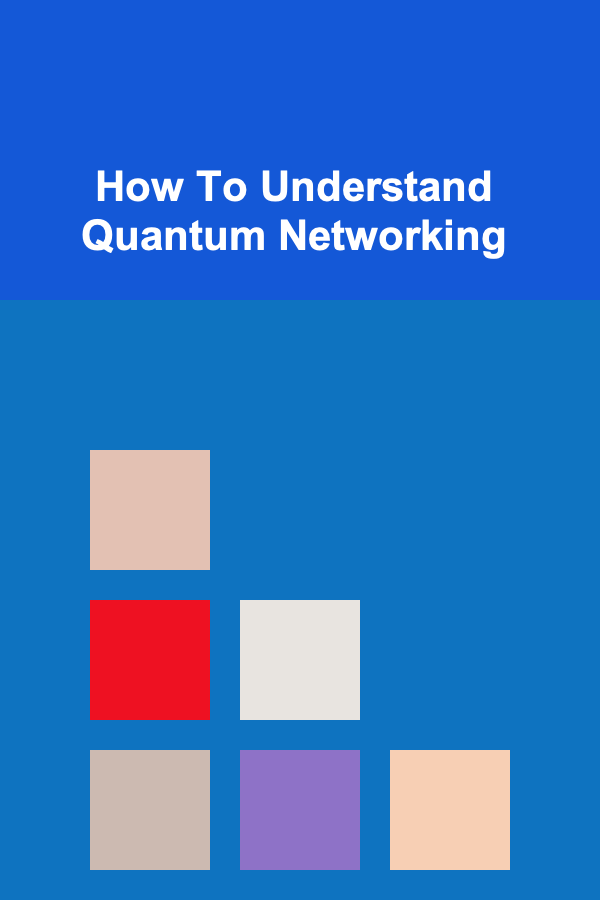
How To Understand Quantum Networking
ebook include PDF & Audio bundle (Micro Guide)
$12.99$9.99
Limited Time Offer! Order within the next:

Quantum networking is an emerging field at the intersection of quantum mechanics and information technology. As the foundation of the next generation of communications, it promises to revolutionize how we transmit information, ensuring ultra-secure data transfer and enabling unprecedented computational power. Understanding quantum networking requires a deep dive into the basic principles of quantum mechanics, quantum information theory, and how these ideas are applied to communication systems. This article will guide you through the essential concepts of quantum networking, its components, and the potential impact it will have on the future of communication and computing.
The Basics of Quantum Mechanics
Before exploring quantum networking, it is crucial to have a solid understanding of quantum mechanics. At the most fundamental level, quantum mechanics deals with the behavior of particles at microscopic scales, such as electrons and photons. Unlike classical physics, where objects have definite positions and velocities, quantum mechanics introduces the idea of uncertainty and probability.
1.1. Superposition
One of the most striking features of quantum mechanics is superposition, which refers to the ability of quantum systems to exist in multiple states at once. For instance, a quantum bit (or qubit) can represent both 0 and 1 simultaneously, unlike classical bits that can only represent one state at a time. This property exponentially increases the computational power of quantum systems, as a quantum computer, for example, can process a vast amount of data in parallel.
1.2. Entanglement
Another essential concept in quantum mechanics is entanglement. When two particles become entangled, their states are no longer independent of each other. Even if they are separated by vast distances, any change in one particle's state will instantaneously affect the state of the other. This phenomenon challenges the classical idea of locality, which holds that information cannot travel faster than the speed of light.
Entanglement is a critical resource in quantum networking because it enables secure communication methods, such as quantum key distribution (QKD), which will be explored later in the article.
1.3. Quantum Measurement
Measurement in quantum mechanics is different from classical mechanics. When a quantum system is measured, its superposition collapses to a definite state. This phenomenon introduces another unique feature of quantum systems: the uncertainty principle, which states that we cannot simultaneously know certain pairs of properties (e.g., position and momentum) of a quantum particle with absolute precision. This has profound implications for how information is processed and transmitted in quantum systems.
What Is Quantum Networking?
Quantum networking involves the creation and use of quantum communication systems that rely on quantum mechanics for transmitting information. The goal of quantum networking is to leverage quantum properties like entanglement and superposition to transmit data in ways that are impossible or highly impractical using classical methods.
In essence, quantum networking allows for the transmission of quantum information across networks of quantum devices, typically photons, that can interact with one another in ways not possible for classical information. This can lead to faster, more secure, and more efficient communication.
2.1. Quantum Communication
Quantum communication refers to methods of transmitting information that leverage quantum mechanics. The most well-known example of quantum communication is Quantum Key Distribution (QKD), which allows two parties to share an encryption key securely, even in the presence of an eavesdropper. The security of QKD comes from the fact that any attempt to intercept the quantum key will disturb the quantum state, thereby alerting the sender and receiver to the potential breach.
Quantum communication systems rely on quantum states such as photons to carry information. These systems can potentially overcome many of the limitations of classical communication systems, such as the vulnerability to interception.
2.2. Quantum Entanglement and Teleportation
Entanglement plays a pivotal role in quantum networking. Entangled particles can be used for a process called quantum teleportation. In quantum teleportation, the quantum state of one particle is transferred to another particle without the particles themselves physically moving. This can allow for instantaneous transmission of information over long distances, a concept that holds vast implications for communication technology.
However, true quantum teleportation requires classical communication to complete the transfer of information, so the "instantaneous" aspect of the process is somewhat nuanced. Nevertheless, the use of entanglement allows for the transfer of quantum information in ways that are far superior to classical methods, especially in terms of security and efficiency.
Components of Quantum Networking
Quantum networks consist of several key components that work together to enable the transfer of quantum information. These include quantum channels, quantum repeaters, quantum computers, and network protocols.
3.1. Quantum Channels
A quantum channel is the medium through which quantum information is transmitted. The most commonly used quantum channel is optical fiber, as it can carry photons efficiently over long distances. However, photons can lose coherence (i.e., the ability to maintain a well-defined quantum state) over long distances, which introduces challenges in maintaining the integrity of quantum information. In free-space communication, quantum information can be transmitted through the air using free-space optical links.
To overcome these challenges, researchers are exploring the use of quantum repeaters, which will be discussed below.
3.2. Quantum Repeaters
Quantum repeaters are devices designed to extend the range of quantum networks. Similar to classical repeaters, quantum repeaters are used to amplify signals over long distances. However, in quantum networks, simply amplifying signals is not enough due to the fragile nature of quantum states.
Instead, quantum repeaters use entanglement swapping and quantum memory techniques to extend the reach of quantum communication. Essentially, a quantum repeater creates a series of entangled pairs of photons at different points along the communication path. When one photon of the pair is transmitted, the other is used to facilitate the transfer of information over long distances. This process helps mitigate the loss of coherence over long distances and ensures the fidelity of quantum information.
3.3. Quantum Computers
Quantum computers are another key component of quantum networking. They perform quantum computations by manipulating qubits in ways that classical computers cannot. Quantum computers can be used to process and store quantum information, which is essential for building larger and more complex quantum networks.
As quantum computers evolve, they will play an increasingly significant role in the development of quantum networking, potentially enabling new forms of distributed computing and data sharing across quantum networks.
3.4. Network Protocols
Quantum networking requires a new set of protocols to facilitate communication between quantum devices. These protocols govern how quantum information is encoded, transmitted, and received. They also ensure the security and reliability of the network.
One of the primary challenges in quantum networking is developing protocols that can function efficiently over long distances. Since quantum information is highly sensitive to noise and interference, ensuring the fidelity of transmitted information is a critical task. Additionally, quantum networks require protocols that allow for the distribution and synchronization of entanglement across the network.
The Role of Quantum Networking in the Future of Communication
Quantum networking has the potential to revolutionize communication systems in several profound ways. Some of the most significant impacts of quantum networking include:
4.1. Enhanced Security
One of the most compelling reasons for pursuing quantum networking is its potential to provide unprecedented security for communications. Quantum Key Distribution (QKD) is a prime example of how quantum networks can ensure the confidentiality of information. In classical systems, encryption can be broken by an eavesdropper with sufficient computing power. However, with quantum encryption methods, any attempt to intercept the communication will disturb the quantum state, revealing the presence of an intruder and ensuring that the transmission remains secure.
Quantum networking can also enable the development of secure communication systems that are immune to many types of cyberattacks. This could have far-reaching applications in sectors such as finance, defense, and health care, where the integrity of data transmission is paramount.
4.2. Faster and More Efficient Communication
Quantum communication systems can also lead to faster and more efficient transmission of information. Quantum entanglement and teleportation can reduce the time it takes to send information between two points, even if they are far apart. While classical systems are bound by the speed of light, quantum systems offer the potential to bypass many of the limitations of classical communication.
Additionally, quantum networks will be able to carry much more data simultaneously, thanks to the unique properties of qubits and superposition. This could significantly increase the bandwidth of communication systems, enabling faster and more reliable data transfer.
4.3. New Frontiers in Computing and Research
Quantum networking will also open up new possibilities for distributed quantum computing. Quantum computers will be able to communicate with one another across a network, allowing them to share information and collaborate on complex computations. This could lead to breakthroughs in fields such as cryptography, artificial intelligence, and material science, where quantum computers could vastly outperform classical computers.
Moreover, quantum networks will enable researchers to share and analyze large sets of quantum data in real-time, potentially accelerating discoveries in quantum science and technology.
Conclusion
Quantum networking represents the future of communication, with the potential to revolutionize how we transfer information and process data. By harnessing the unique properties of quantum mechanics, such as superposition, entanglement, and quantum measurement, quantum networks promise to provide ultra-secure communication, faster transmission speeds, and greater computational power. While the field is still in its infancy, the progress made in recent years suggests that quantum networks will soon become a reality. As we move toward a more connected and digitally driven world, quantum networking will play a key role in shaping the next generation of communication technology.

How to Reassess Your Financial Situation After a Setback
Read More
How to Store Large Items Like Luggage and Sports Gear Efficiently
Read More
How to Use Vertical Space for Storing Seasonal Items
Read More
Top DIY Pet Grooming Tips to Save Money and Keep Your Pet Healthy
Read More
Decluttering Your Gardening Supplies: A Comprehensive Guide
Read MoreHow to Build a Fixed Expenses Tracker in Google Sheets
Read MoreOther Products

How to Reassess Your Financial Situation After a Setback
Read More
How to Store Large Items Like Luggage and Sports Gear Efficiently
Read More
How to Use Vertical Space for Storing Seasonal Items
Read More
Top DIY Pet Grooming Tips to Save Money and Keep Your Pet Healthy
Read More